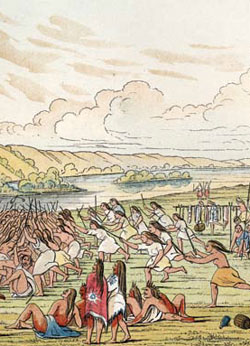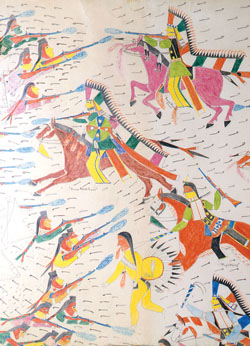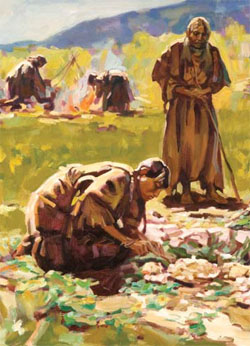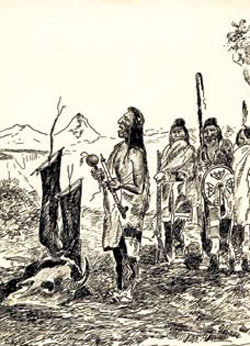Montana: Stories of the Land
Companion Website and Online Teacher's Guide
Chapter 3 - From Dog Days to Horse Warriors
Chapter 1 - Montana: Where the Land Writes History
Chapter 2 - People of the Dog Days
Chapter 3 - From Dog Days to Horse Warriors
Chapter 4 - Newcomers Explore the Region
Chapter 5 - Beaver, Bison, and Black Robes
Chapter 6 - Montana's Gold and Silver Boom
Chapter 7 - Two Worlds Collide
Chapter 8 - Livestock and the Open Range
Chapter 9 - Railroads Link Montana to the Nation
Chapter 10 - Politics and the Copper Kings
Chapter 11 - The Early Reservation Years
Chapter 12 - Logging in the "High Lonesome"
Chapter 13 - Homesteading This Dry Land
Chapter 14 - Towns Have Lives, Too
Chapter 15 - Progressive Montana
Chapter 16 - Montana and World War I
Chapter 17 - Montanans on the Move
Chapter 18 - The Great Depression Transforms Montana
Chapter 19 - World War II in Montana
Chapter 20 - Building a New Montana
Chapter 21 - A People's Constitution
Chapter 22 - Living in a New Montana
Educator Resources
Who Arrived in Montana When?
There is a fair amount of dissension among tribal cultural experts, historians, and others about when various tribes arrived in Montana and from where they came. We've done our best to present as accurate a story as we could in this chapter, but teachers should be aware that experts disagree. This might be a good place to talk about how we know what we know. (See Essential Understanding #3 for more details.)
Educational Trunks
-
Montana's First People: Essential Understandings from the Montana Historical Society. This trunk explores the Seven Essential Understandings Regarding Montana Indians and includes pre-contact and contact-era trade items, a parfleche, drum, elk tooth dress, horse model, ration coupon bag, boarding school outfits, beaver pelt and bison hide, maps, illustrations, tribal flags, and more.
-
Montana Indian Stories Lit Kit from the Montana Historical Society. This trunk immerses students in storytelling and the oral tradition with seven class sets of Montana Indian stories collected for the Indian Reading Series (1972) and reprinted by the Montana Historical Society Press. The lit kit includes animal puppets and User Guide. NOTE: Out of respect for the storytelling customs of many Montana Indian people, this kit will be made available for use in the winter months (November through March).
Takeaways
Inspired by reading specialist Tammy Elser, who was in turn inspired by SKC graduate Taylor Crawford, we've created a "Takeaway" bookmark for every chapter of Montana: Stories of the Land. Before starting a chapter, print and cut out these bookmarks and distribute them to your students. Ask them to use the Takeaway to summarize the GIST of what they learn from reading assigned sections of the chapter. Remind them that they don't have much room, so they'll need to think before they write down the most important idea they want to take away from the section. Learn a little more about the GIST strategy.
Even though we've created Takeaways for every chapter, we don't recommend you have your students complete a Takeaway for every section of every chapter they read. That would be exceedingly tedious. However, used appropriately, they can be a useful tool for encouraging reflection and teaching students how to summarize information.
Websites and Online Lesson Plans
-
The resources related to Montana's Indian tribes are vast. The Indian Education Division of the Office of Public Instruction is an excellent clearinghouse.
-
Montanatribes.org includes learning activities and a digital archives, where you can find hundreds of short video clips video clips addressing a wide spectrum of topics from tribal perspectives. The interviews are organized around the Essential Understandings, and touch on issues from sovereignty to cultural continuity, to individual and tribal diversity.
-
Neither Empty nor Unknown: Montana at the Time of Lewis and Clark Lesson Plan (4-7). For teachers able to bring their students to the Montana Historical Society, this lesson plan offers pre- and post-tour lessons and other resources to complement a tour of the Neither Empty nor Unknown exhibit. (Find information about scheduling tours here.) For those unable to tour the exhibit, the lesson plan offers instructions for modifying the lesson and a "virtual tour" via PowerPoint and script. You can preview the virtual tour PowerPoint here.
Videos or DVDs
-
Women's Work with Laura Ferguson - 6 minutes
-
Tribes of Montana and How They Got Their Names - 35 minutes
- Horse | Caballo, created by the Smithsonian National Museum of the American Indian - 7 minutes
Possible Field Trips: View the Map
-
Three Chiefs Cultural Center, St. Ignatius
-
Fort Peck Assiniboine and Sioux Culture Center and Museum, Poplar
-
Montana Historical Society, Helena, especially the exhibit "Neither Empty Nor Unknown: Montana at the Time of Lewis and Clark"
-
Museum of the Plains Indian, Browning
-
Museum of the Rockies, Bozeman
-
St. Labre Indian School and Museum, Ashland
Chapter 3 Test and Answer Keys Page
The tests and answer keys are password protected.
You can contact us to receive the password:
- Martha Kohl - call (406) 444-4790 or email mkohl@mt.gov
- Melissa Hibbard - call (406) 444-4741 or email Melissa.Hibbard@mt.gov
Or, if you used the old system, the original username is now the new password. You will be asked for this case-sensitive password every time you open a new document.
Alignment to ELA Common Core Standards
Alignment to Content Standards and Essential Understandings Regarding Montana Indians (EU)




